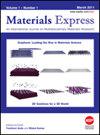Antibacterial behavior and mechanism of nitrogen, silicon-doped amphiphilic carbon dots
IF 0.7
4区 材料科学
Q3 Materials Science
引用次数: 0
Abstract
A new kind of amphiphilic carbon dots (CDs) was prepared with citric acid and silane coupling agent as raw materials. Due to the doping of nitrogen and silicon elements, the surface of CDs contains not only oxygen-containing functional groups, but also alkyl hydrophobic chains, showing amphiphilic characteristic. The micro molecular structure and elemental composition of CDs were investigated by transmission electron microscopy (TEM), X-ray diffraction (XRD), and other tests. The antibacterial behavior of CDs against Escherichia coli (E. coli) and Staphylococcus aureus (S. aureus) was studied by the disk antibacterial method, plate colony, scanning electron microscopy (SEM) and other methods. The biocompatibility of CDs was evaluated by cytotoxicity and hemolysis in vitro. The results proved that CDs possessed the average particle size of 1.75 nm and the negative surface potential of −2.71 mV. For E. coli and S. aureus, the minimum bactericidal concentrations of CDs were 500 μg/mL and 400 μg/mL, respectively. These co-doped CDs also possessed the ability to inhibit biofilm formation. The antibacterial mechanism was mainly through the adsorption force to rupture the bacterial membrane and induce the generation of reactive oxygen species in bacterial cells. In addition, CDs exhibited excellent biocompatibility because of their low cytotoxicity and hemolysis, indicating that they can be used as a new material in the antibacterial field.掺氮、硅两亲性碳点的抗菌行为和机理
以柠檬酸和硅烷偶联剂为原料制备了一种新型两亲性碳点(CDs)。由于氮元素和硅元素的掺杂,CD表面不仅含有含氧官能团,还含有烷基疏水链,呈现出两亲性特征。通过透射电子显微镜(TEM)、X 射线衍射(XRD)和其他测试,研究了 CD 的微分子结构和元素组成。通过盘式抗菌法、平板菌落、扫描电镜等方法研究了 CD 对大肠杆菌和金黄色葡萄球菌的抗菌性能。体外细胞毒性和溶血作用评估了 CD 的生物相容性。结果表明,CD 的平均粒径为 1.75 nm,表面负电位为 -2.71 mV。对于大肠杆菌和金黄色葡萄球菌,光盘的最小杀菌浓度分别为 500 μg/mL 和 400 μg/mL。这些共掺杂 CD 还具有抑制生物膜形成的能力。其抗菌机制主要是通过吸附力使细菌膜破裂,诱导细菌细胞中活性氧的生成。此外,CD 的细胞毒性和溶血率都很低,因此具有很好的生物相容性,这表明它可以作为一种新材料应用于抗菌领域。
本文章由计算机程序翻译,如有差异,请以英文原文为准。
求助全文
约1分钟内获得全文
求助全文
来源期刊

Materials Express
NANOSCIENCE & NANOTECHNOLOGY-MATERIALS SCIENCE, MULTIDISCIPLINARY
自引率
0.00%
发文量
69
审稿时长
>12 weeks
期刊介绍:
Information not localized
文献相关原料
| 公司名称 | 产品信息 | 采购帮参考价格 |
|---|
 求助内容:
求助内容: 应助结果提醒方式:
应助结果提醒方式:


